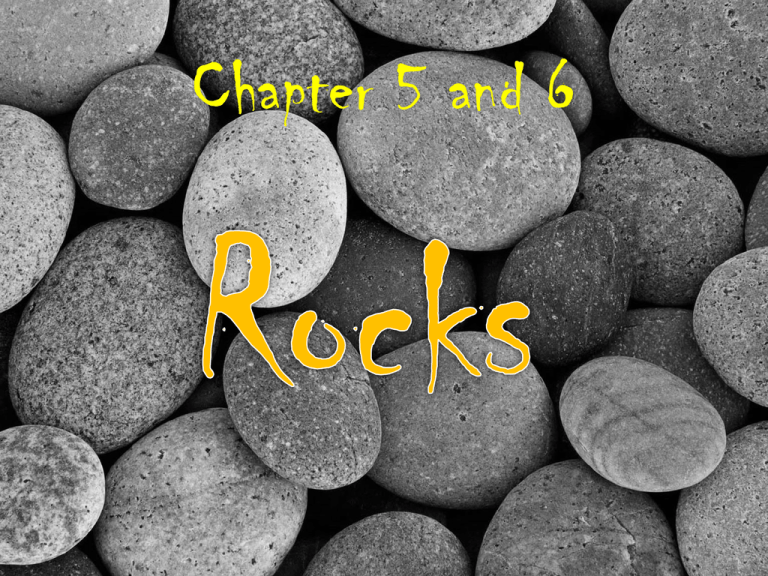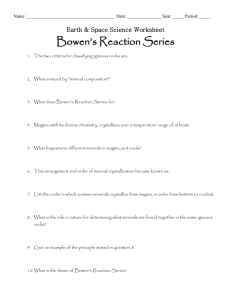Igneous rocks - Cloudfront.net
advertisement

Chapter 5 and 6 Section 5.1 • Igneous rocks are formed from the crystallization of magma • • Igneous comes from Latin ignis which means fire Lava is magma that flow out onto earth's surface • Extrusive igneous rocks are fine-grained igneous rocks that cool quickly on earth’s surface • • Intrusive igneous rocks are coarse grained igneous rocks that cool slowly beneath the earth’s surface • • Pumice or obsididan Granite is the most common Studies of granite formations reveal they cut across other formations, evidence of intrusion Magma is a slushy mix of molten rock, gases and mineral crystals Silica (SiO2) is the most abundant mineral in magma and has the greatest effect on magma characteristics Temperature, pressure, water content and mineral composition affect magma formation Temperature and pressure increase with depth in the Earth’s crust Pressure increases a rocks melting point o 1100 vs 1400 Rocks and minerals contain small percentages of water which decreases a rocks melting point Minerals have different melting points Rocks only melt at certain conditions MUST have the right temperature, pressure, and mineral composition Rocks are made of different minerals Minerals have different melting points so parts of a rock will melt at different times Partial melting is a process where some minerals melt at low temperatures while others stay solid Just as minerals melt at different rates, they cool at different rates as well Fractional crystallization is a process where minerals forma at different temperatures The last minerals to melt are the first minerals to crystallize Section 5.2 Three main groups of igneous rocks o Felsic, mafic, intermediate Felsic rocks such as granite are: light colored, high silica contents, contain quartz and feldspars Mafic rocks such as gabbro are dark colored, and rich in iron and magnesium Igneous rocks differ in the size of their grains Grain size is determined by the cooling rate When lava cools quickly, small grains form When lava cools slowly, large grains form Very useful for building materials because their interlocking grains make them strong Also resistant to weathering Granite is commonly used for building Ores are minerals that contain a useful substance that can be mined at profit Valuable ore deposits are often associated with igneous intrusions Mineral rich magma fills the cracks and voids of surrounding rock During magma crystallization, water, silica and any metals not common in minerals (gold, silver, lead, copper) are left over and eventually solidify to form veins Vein deposits main contain other valuable resources in addition to metals Veins of extremely large grained minerals are called pegmatites Rare elements and crystals are found in pegmatites Rare, ultramafic rocks that can contain diamonds or other minerals formed only under very high pressures Section 6.1 Sediments are pieces of solid material that have been deposited on Earth’s surface by wind, water, ice, gravity or chemical precipitation When sediments become cemented together, they form sedimentary rocks Weathering is a set of physical and chemical processes that break rock down Chemical weathering occurs when rocks are dissolved or chemically changed Physical weathering occurs when rocks break off but remain chemically unchanged Erosion is the removal and movement of surface materials from location to another 4 main agents: Wind, moving water, glaciers and gravity Deposition occurs when sediments are laid down on the ground or sink to the bottom of water Sediments in water will create layers, with large particles settling first Wind only moves fine sediments Glaciers and landslides move all sediments equally Most sediments are deposited in basins where the building layers increase pressure and temperature Increasing pressure and temperature cause lithification, or the chemical and physical processes that transform sediments into sedimentary rocks Lithification begins with compaction The weight of overlying sediments force sediments together The temperature in earth's crust are high enough to cause cementation Cementation occurs when mineral growth cements sediments together into solid rock Two types of cementation New minerals can grow between sediment grains The same mineral grows between the sediment grains The primary feature of sedimentary rocks is horizontal layering called bedding Bedding with particle sizes that become heavier at the bottom is called graded bedding Cross-bedding is another type of bedding where layers of inclined sediment move forward across a horizontal surface Section 6.3 Meta means change and morphe means forms During metamorphism, rocks change form while remaining solid Pressure and temperature increase with depth Temperature comes from earths internal heat Pressure comes from overlying rocks or compression during mountain building When high temperature and pressure affect large regions of crust, they produce large belts of regional metamorphism When molten rock come into contact with solid rock, a local effect called contact metamorphism occurs When very hot water reacts with rocks and alters its chemistry and mineralogy, hydrothermal metamorphism occurs o Occurs near igneous intrusions and active volcanoes Metamorphic rocks have two textural groups: foliated and nonfoliated Wavy layers and bands of minerals of flat crystals characterize foliated metamorphic rocks o Schist from shale (clay) and gneiss from granite If I said you were gneiss, I’d be for of schist! lol Nonfoliated rocks lack mineral grains with flat crystals and instead have blocky crystal shapes o Quartzite from quartz-rich sandstone and marble from limestone The continuous changing and remaking of rocks is called the rock cycle Igneous rocks crystalize from magma Sediments cement together to form sedimentary Pressure and temperature form metamorphic rock All rocks can change into one another!




